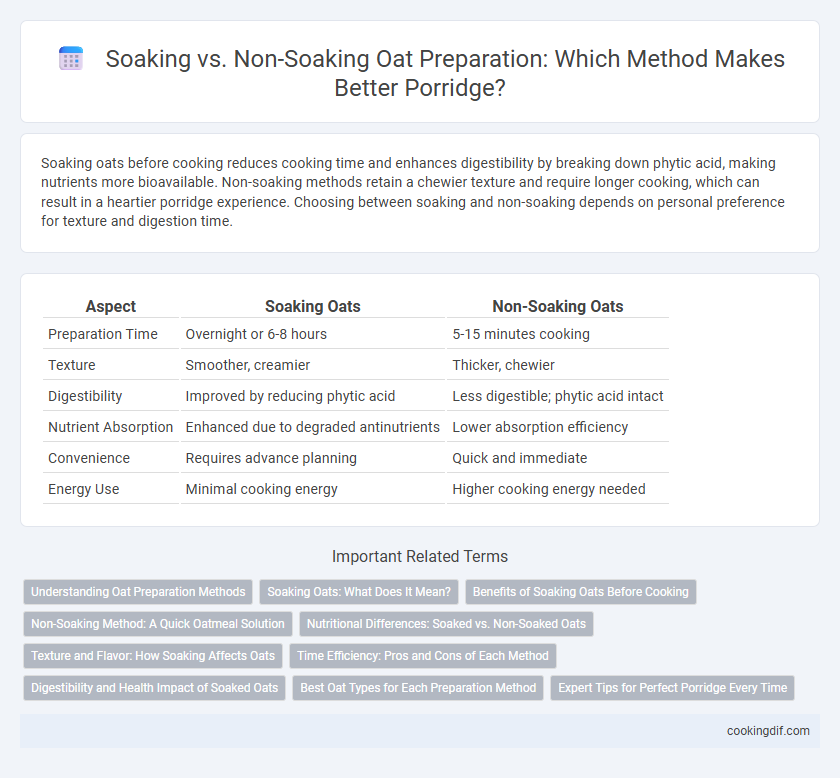Soaking oats before cooking reduces cooking time and enhances digestibility by breaking down phytic acid, making nutrients more bioavailable. Non-soaking methods retain a chewier texture and require longer cooking, which can result in a heartier porridge experience. Choosing between soaking and non-soaking depends on personal preference for texture and digestion time.
Table of Comparison
| Aspect | Soaking Oats | Non-Soaking Oats |
|---|---|---|
| Preparation Time | Overnight or 6-8 hours | 5-15 minutes cooking |
| Texture | Smoother, creamier | Thicker, chewier |
| Digestibility | Improved by reducing phytic acid | Less digestible; phytic acid intact |
| Nutrient Absorption | Enhanced due to degraded antinutrients | Lower absorption efficiency |
| Convenience | Requires advance planning | Quick and immediate |
| Energy Use | Minimal cooking energy | Higher cooking energy needed |
Understanding Oat Preparation Methods
Soaking oats overnight enhances their digestibility by breaking down phytic acid, which inhibits nutrient absorption, making minerals like iron and zinc more bioavailable. Non-soaking methods, such as quick cooking or boiling, save time but may result in a firmer texture and less nutrient accessibility. Understanding these preparation methods helps optimize nutrient intake and texture preferences in porridge.
Soaking Oats: What Does It Mean?
Soaking oats involves immersing them in water or milk for several hours or overnight, which helps break down phytic acid and improves nutrient absorption. This process softens the oats, reducing cooking time and enhancing digestibility, while also promoting a creamier porridge texture. Soaked oats retain more vitamins and minerals, making them a nutritious and convenient option for a wholesome breakfast.
Benefits of Soaking Oats Before Cooking
Soaking oats before cooking significantly enhances nutrient absorption by breaking down phytic acid, which inhibits mineral uptake such as iron, zinc, and calcium. This process also reduces cooking time and improves texture, resulting in creamier, more digestible porridge. Furthermore, soaking activates beneficial enzymes and decreases anti-nutrients, promoting better gut health and optimizing energy release from the oats.
Non-Soaking Method: A Quick Oatmeal Solution
The Non-Soaking Method for oat preparation offers a rapid solution by cooking oats directly without prior soaking, preserving texture and enhancing the natural oat flavor. This method saves time, making it ideal for quick breakfasts while maintaining essential nutrients like beta-glucan fibers and antioxidants. Cooking oats instantly also helps retain a firmer consistency compared to soaking, appealing to those who prefer a chewier porridge experience.
Nutritional Differences: Soaked vs. Non-Soaked Oats
Soaking oats before cooking activates enzymes that break down phytic acid, enhancing mineral absorption such as iron, zinc, and calcium. Non-soaked oats retain higher levels of phytic acid, which can reduce nutrient bioavailability but maintain a firmer texture and longer shelf life. Soaked oats often have increased digestibility and may provide better nutrient utilization, especially in those with sensitive digestion or mineral absorption concerns.
Texture and Flavor: How Soaking Affects Oats
Soaking oats overnight enhances their texture by making them softer and creamier, allowing for a smoother porridge experience. The soaking process also activates enzymes that break down starches, resulting in a sweeter, more developed flavor compared to non-soaked oats. In contrast, non-soaked oats tend to retain a chewier texture and a more neutral taste, requiring longer cooking times to achieve softness.
Time Efficiency: Pros and Cons of Each Method
Soaking oats overnight reduces cooking time significantly, offering a quick and convenient breakfast option, especially for busy mornings. Non-soaking methods require longer cooking, generally around 10-15 minutes, but allow for freshly prepared porridge with a creamier texture. Soaking improves digestibility and nutrient availability, while non-soaked oats retain a firmer bite and can save prep steps earlier in the day.
Digestibility and Health Impact of Soaked Oats
Soaking oats enhances digestibility by breaking down phytic acid and activating enzymes that improve nutrient absorption, leading to better gut health and reduced bloating. This pre-treatment increases the bioavailability of minerals such as iron, zinc, and calcium, which are often inhibited in non-soaked oats. Consuming soaked oats regularly can contribute to improved digestion and a healthier inflammatory response compared to non-soaked oat consumption.
Best Oat Types for Each Preparation Method
Steel-cut oats are ideal for soaking due to their dense texture and longer cooking time, which softens them perfectly in cold water overnight. Rolled oats, with their flattened and slightly processed form, cook quickly without soaking and are preferred for instant porridge preparation. Whole oat groats benefit more from soaking to reduce cooking time and enhance digestibility, making them suitable for slow-cooked or overnight porridges.
Expert Tips for Perfect Porridge Every Time
Soaking oats overnight enhances texture by softening the grains, reducing cooking time, and improving digestibility. Non-soaking oats require longer cooking but offer a chewier consistency preferred in traditional porridge recipes. Expert tips recommend soaking rolled or steel-cut oats in water or milk for at least 6 hours to achieve creamy, evenly cooked porridge with optimal flavor absorption.
Soaking vs non-soaking for oat preparation Infographic

 cookingdif.com
cookingdif.com